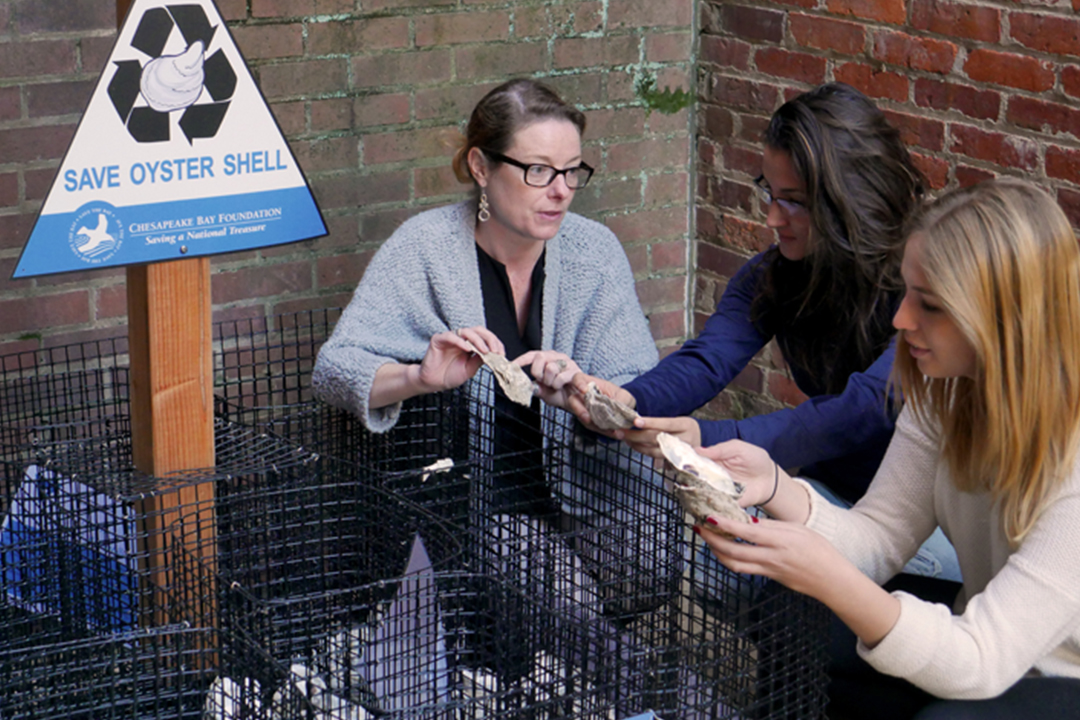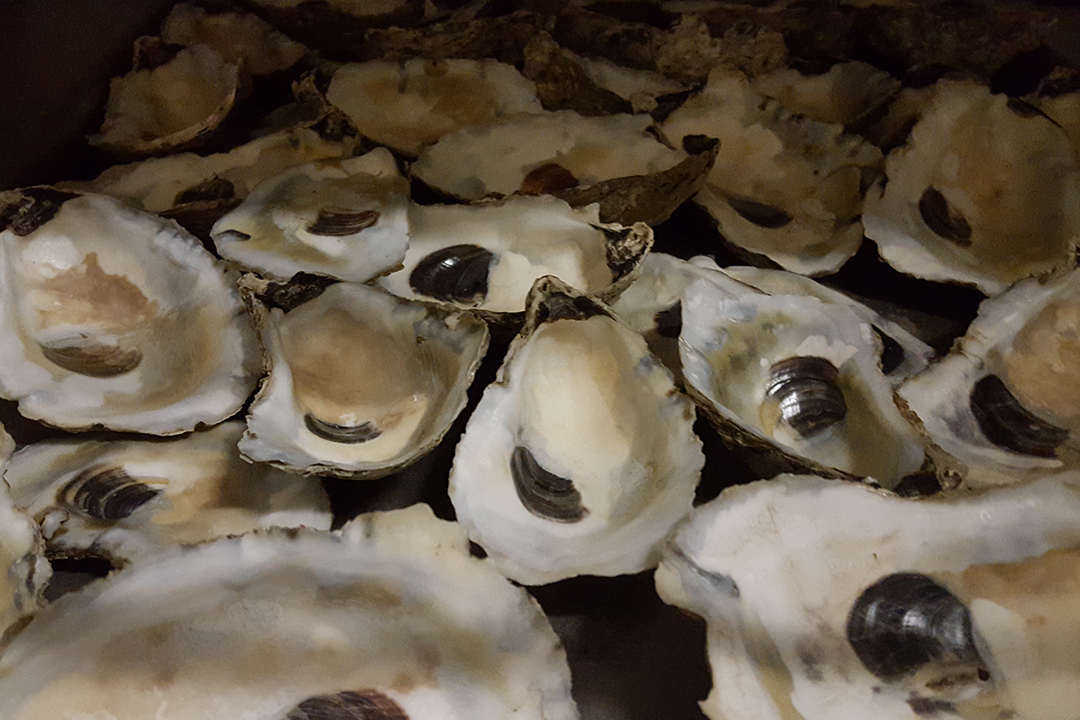By John DiConsiglio
They call it “Oyster Alley”—a narrow strip of concrete tucked in an alcove beside Bell Hall. There you’ll find a meshed wire bin overflowing with oyster shells. The husks come from all over the D.C. area—discards from Whole Foods, half shells from restaurants, donated leftovers from in-home meals. And while Oyster Alley may be no more than five feet wide, Assistant Professor of Biology Tara Scully says the small space has a big goal: restoring the fading oyster population in the Chesapeake Bay and saving an entire aquatic ecosystem.
“This looks like a very small step, but every little bit helps,” she said, noting that the shells will be donated to the Chesapeake Bay Foundation where they will be used to spawn baby oysters and address the ecological crisis threatening one of the world’s most important waterways. “Even if we are just putting one more oyster into the bay, the impact can be profound.”
Created by students, Oyster Alley is one of several research and conversation efforts spearheaded by Scully through her service-learning class Understanding Organism Through Service. In addition to encouraging the shell collection project, students from Scully’s class are raising oysters in Bell Hall tanks and measuring the effects of herbicides and pesticides on the bay’s marine life.
“We are taking too many oysters out of the bay. But even the ones that are left in the water are still being eradicated” by chemical and agricultural pollutants, said senior environmental studies major Adrian Britt, the lead researcher in Scully’s herbicide experiment. “This is a crisis. It will take a lot of work inside and outside of the lab to address it.”
‘The Lungs of the Bay’
At 200 miles long, stretching from Havre de Grace to Virginia Beach, the Chesapeake Bay is the largest estuary in the United States and third largest in the world. Oysters are, in many ways, the life source of the bay. Not only are they the region’s most valuable fishery, oysters play a crucial role in everything from improving water quality to preserving marine life.
Dubbed the “lungs of the bay,” oysters are a “wonderful natural filtration system,” Scully said, clearing algae, sediment and other pollutants from the bay. Indeed, one oyster can filter 50 gallons of water a day. A variety of sea life also depends on the oyster for their survival. As oysters repopulate, for example, they build reefs that provide food for small fish and crabs. Oyster shells also serve as homes for organisms like sea anemones and barnacles.
“When you think about preserving bay life, you don’t necessarily think about worms or barnacles,” Scully said. “But just like the animals we love—blue crabs, herons, osprey—a lot of organisms rely on the trophic system that centers on the oyster.”
In the 1600s, oysters were so plentiful in the bay that reefs racking above the water surface were navigational hazards for ships. But a range of man-made threats—from overharvesting to chemical pollution to agricultural runoff —have sent the oyster population plummeting to just one percent of its historic level. Fertilizers, pesticides and animal waste from nearby farms stimulate algae blooms, sucking oxygen from the water and hindering oyster larvae growth. When oysters die, fish and their predators soon follow, endangering the entire ecosystem and affecting locals who rely on the bay for their livelihood. Over the last three decades, oyster decline has cost Chesapeake businesses more than $4 billion and cut more than 7,000 oystermen jobs.
From her house in Reedville, Va., where the Rappahannock and Potomac meet the bay, Scully and her family have long volunteered with bay preservation efforts. “It struck me as a biologist teaching ecology that I should think more about what I can do to offer students the opportunity to get involved as well,” she said.
Britt needed little incentive to join Scully’s bay crusade. As a D.C. native, his connections to the bay stretch back to childhood, when he and friends sailed the bay waters and its tributaries as far north as Rehoboth. “I love marine life,” he said. “In the summer, we would see horseshoe crabs spawning in the bay. But over the years, some of that natural habitat has been destroyed.”
The Chesapeake Bay’s oyster population has plummeted to one percent of its historic level.
As an assistant in Scully’s lab, Britt has focused on spawning and maintaining baby oysters—or “spats”—which are then donated to bay restoration societies. With Scully, Britt has embarked on a new project to test how atrazine— the second most commonly used herbicide in the United States and a carcinogen banned by the European Union— affects the growth of oysters, their food and their immune response to infection.
The students who initiated the shell collection project—nicknamed the “GW Baywatchers”—had little biology background or knowledge of the bay. “I’d never eaten an oyster in my life and I knew almost nothing about the bay,” said Hannah Finkel, a history and Judaic studies double major and Baywatcher-founder. “I guess I thought of oysters as appetizers—not something that pretty much sustain an entire ecological system.”
Finkel and sophomore communications major Diana Kussainova realized their talents were best suited to efforts outside of the lab. Moved by Scully’s passion for bay restoration, they launched the shell collection program, building the Oyster Alley bins and spreading the recycling message through social media and word of mouth. This semester, Scully’s students will work with local supermarkets, shops and restaurants to collect donated shells. Even discarded shells shucked of actual oysters are crucial in repopulating the bay, they noted. Oyster larvae must attach to an adult shell within the first two weeks of their lives to survive. “There are all those potential baby oysters floating around in the bay, and if they can’t find a shell, they won’t make it,” Kussainova said.
Scully and her students say they are optimistic about the long-term health of the bay, pointing to a 2010 executive order by President Obama limiting pollutants from impaired waterways. At the same time, many oystermen are reversing the decades-long trend of overharvesting and turning to more aquacultural approaches that are less stressful on the existing oyster population. And while Scully’s students are operating on a modest scale, they are confident that—like the once endangered blue crab—the oyster can make a comeback.
“We are just one little lab; we aren’t going to breed enough oysters or collect enough shells to repopulate the bay,” Britt said. “But can we lay the foundation for future environmental legislation? Can we educate farmers about the true impact of atrazine so maybe they will consider using something else? Can we make a real difference? I believe we can.”



